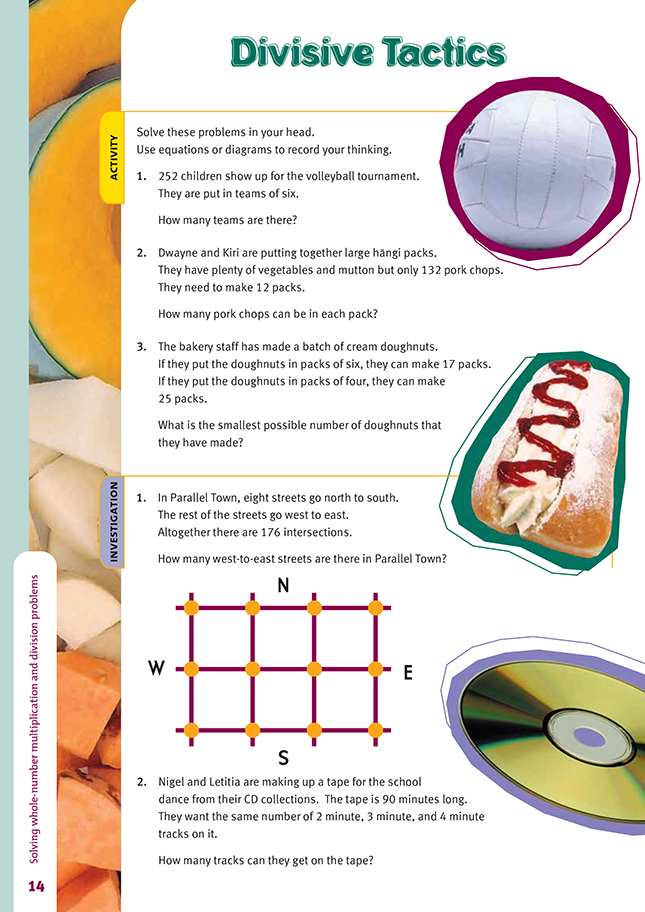This is a level 4 number link activity from the Figure It Out series. It relates to Stage 7 of the Number Framework.
A PDF of the student activity is included.
Click on the image to enlarge it. Click again to close. Download PDF (184 KB)
use mental strategies to solve multiplication and division problems
FIO, Link, Number, Book Two, Decisive Tactics, page 14
Like those on the previous two pages, this activity helps students to develop thinking strategies. Allow the students to ask for the answer to a number fact that they need to help them with their thinking. This fact can be recorded for memorisation at a later date. Keep the students focused on looking for connections between
what they know and what the problem is asking them to do.
For question 1, which involves the equation 252 ÷ 6 = , the students may see that it’s useful to break 252 into 240 + 12 because of the fact that 24 ÷ 6 = 4, so 240 ÷ 6 = 40. They will be more likely to see this connection for themselves if you revise multiplying and dividing a number by 10 in the maintenance part of the lesson before the students attempt these problems.
For question 3, the students will need to find two equations and compare them:
÷ 6 = 17 and ÷ 4 = 25. By changing these to multiplication, they will find two answers, 102 and 100.
You may need to direct them back to the question, which asks for the lowest number needed to fit both situations.
Investigation
For question 1, the students may need to model a similar situation with easier numbers to see the multiplication relationship between the number of streets in each direction and the number of intersections.
Question 2 has a number of interesting possibilities, but some students may feel overwhelmed by the three sets of relationships involved, namely the 2 minute, 3 minute, and 4 minute tracks. If they get frustrated, suggest that they explore the number of tracks if a 2 minute track was followed by a 3 minute track and this
was followed by a 4 minute track. This should help them see that it takes 9 minutes to run one track of each length, and so, after 90 minutes, they will have done 10 tracks of each type. At this stage, they may need to look at the question again to see that it asks for the total number of tracks, which is 30.
Answers to Activity
Answers and possible methods are:
1. 42 teams
252 ÷ 6 =
6 x 4 = 24, so
240 ÷ 6 = 40
12 ÷ 6 = 2
40 + 2 = 42
2. 11 pork chops in each pack
132 ÷ = 12. Change to:
12 x = 132
12 x 10 = 120, so 12 x 11 = 132
3. 102 doughnuts (with two left over from the four-packs)
÷ 6 = 17
÷ 4 = 25
6 x 17 = 102
4 x 25 = 100
Investigation
1. There are 22 west-to-east streets.
176 ÷ 8 =
8 x 2 = 16, so
160 ÷ 8 = 20
16 ÷ 8 = 2
20 + 2 = 22
2. 30 tracks
One of each track length gives 2 + 3 + 4 = 9 minutes. 90 ÷ 9 = 10. So they can get 10 x 3 = 30 tracks on the tape.
